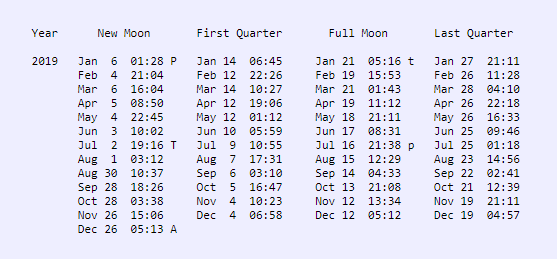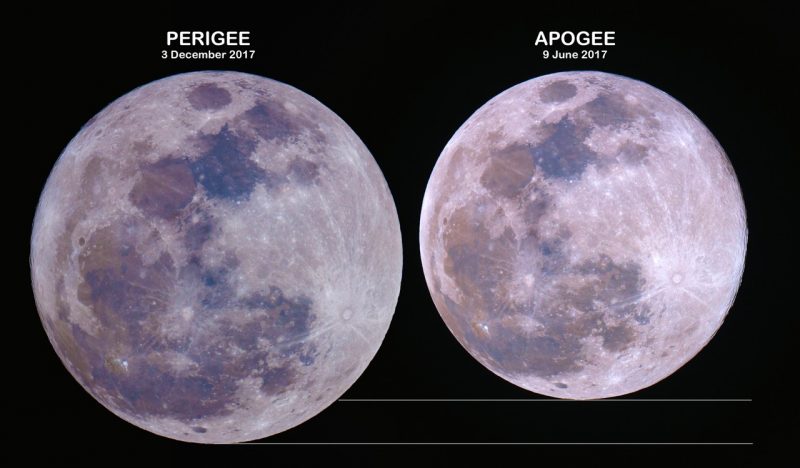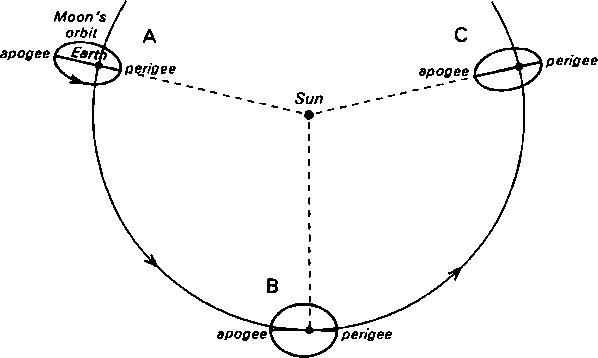
Above: Simulated bird’s-eye view of the Earth and moon at first quarter phase, as seen from the north side of the moon’s orbital plane.
This month’s first quarter moon comes on December 4, 2019, at 6:58 UTC. If you’re in the Americas, you can look for it on the evening of December 3. As viewed from the whole Earth, a 1st quarter moon is high up at sunset, looking like half a pie. There are a total of 12 first quarter moons in 2019, but this one counts as the most distant of them all, at 250,990 miles (403,929 km) from Earth. That’s because this December first quarter moon aligns more closely with lunar apogee – the moon’s farthest point from Earth in its monthly orbit – than any other first quarter moon in 2019.
First quarter moon: December 4 at 6:58 UTC
Lunar apogee: December 5 at 4:09 UTC

Dates for the moon’s phases in 2019 via Astropixels.
One fortnight (approximately two weeks) after the year’s farthest first quarter moon on December 4, it’ll be the year’s closest last quarter moon on December 19, at 4:57 UTC. That’s because this December last quarter moon gives us the year’s closest coincidence of last quarter moon with lunar perigee – the moon’s nearest point to Earth in its monthly orbit. This December last quarter moon sweeps to within 230,086 miles (370,287 km) of Earth.
Last quarter moon: December 19 at 4:57 UTC
Lunar perigee: December 18 at 20:30 UTC
That places the December 2019 last quarter moon nearly 21,000 miles (34,000 km) closer to Earth than the December 2019 first quarter moon.
Yet, seven first quarter moons previous to December 4 – on May 12, 2019 – it was the closest first quarter moon of the year, at 229,940 miles (370,053 km) away.
First quarter moon: May 12 at 1:12 UTC
Lunar perigee: May 13 at 21:53 UTC

The 13 lunar perigees and 13 lunar apogees in 2019. M = most distant perigee and apogee; m = closest perigee and apogee. Table via Astropixels
And seven last quarter moons before December 19 – on May 26, 2019 – it was the farthest last quarter moon of the year, at 251,113 miles (404,126 km) distant.
Last quarter moon: May 26 at 16:34 UTC
Lunar apogee: May 26 at 13:27 UTC
Once again, that’s a difference of about 21,000 miles (34,000 km) between the May 2019 first and last quarter moons.
To recap:
2019 May 12: year’s closest first quarter moon (229.940 miles or 370, 053 km)
2019 May 26: year’s farthest last quarter moon (251,113 miles or 404,126 km)Seven lunar months later:
2019 Dec 04: year’s farthest first quarter moon (250,990 miles or 403,929 km)
2019 Dec 19: year’s closest last quarter moon (230,086 miles or 370,287 km)
For the fun of it, let’s look at the distances of the new/full moons that most closely align with lunar apogee/perigee in 2019:
2019 Feb 04: year’s farthest new moon (252,566 miles or 406,466 km)
2019 Feb 19: year’s closest full moon (221,736 miles or 356,846 km)Seven lunar months later:
2019 Aug 30: year’s closest new moon (221,971 miles or 357,227 km)
2019 Sep 14: year’s farthest full moon (252,431 miles or 406,248 km)
That’s a difference of about 30,000 miles (50,000 km) between the apogee/perigee new/full moons – in stark contrast to the 21,000 miles (34,000 km) difference between apogee/perigee quarter moons.

Here’s a far moon/near moon comparison between the December 3, 2017 close full moon and 2017’s farthest full moon in June by Muzamir Mazlan at Telok Kemang Observatory, Port Dickson, Malaysia.
More impressive, perhaps, a new moon or full moon coinciding with perigee comes about 8,000 miles (13,000 km) closer to Earth than does a first or last quarter moon at perigee. Neil Degrasse Tyson, in an interview once claimed, “The distance to the moon – okay, the moon orbits us. It’s sometimes closer and it’s sometimes farther away. It has nothing to do with the phase.”
On the contrary, a quarter moon at perigee doesn’t sweep as close to Earth as a new or full moon at perigee; conversely, a quarter moon at apogee doesn’t swing as far out from Earth as a new or full moon at apogee. In other words, a quarter moon can never get as close to Earth as a supermoon (new or full moon near perigee) or as far away as a micro-moon (new or full moon near apogee).
For those brave souls wanting to know why quarter moons at perigee/apogee don’t get as close – or as far – as new and full moons at perigee or apogee, we provide an explanation below.

Diagram via Bedford Astronomy Club. The line connecting lunar perigee with lunar apogee defines the moon’s major axis. At (A) the major axis is pointing directly at the sun, maximizing the eccentricity of the moon’s orbit. At this elongated eccentricity, perigee is maximally close and apogee maximally distant, giving rise to a perigee new moon (supermoon) and an apogee full moon (micro-moon). Then, 3.5 lunar months (103 days) later, at (B), the moon’s major axis makes a right angle to the sun-Earth line. This minimizes the eccentricity, however, lessening the apogee distance yet increasing the perigee distance; and that’s why the quarter moons at perigee/apogee never get as close or as far from Earth as perigean/apogean new or full moons. Seven lunar months (206 days) after the major axis points directly at the sun at (A), it points toward the sun at (C) – except that it’s an apogee new moon (micro-moon) and perigee full moon (supermoon). Generally, the closest perigee comes at full moon and the farthest apogee at new moon.
Even though the year’s farthest first quarter moon comes on December 4, 2019. the moon actually reached its farthest point from Earth for the year on February 5, 2019.
from EarthSky https://ift.tt/34O1xPW

Above: Simulated bird’s-eye view of the Earth and moon at first quarter phase, as seen from the north side of the moon’s orbital plane.
This month’s first quarter moon comes on December 4, 2019, at 6:58 UTC. If you’re in the Americas, you can look for it on the evening of December 3. As viewed from the whole Earth, a 1st quarter moon is high up at sunset, looking like half a pie. There are a total of 12 first quarter moons in 2019, but this one counts as the most distant of them all, at 250,990 miles (403,929 km) from Earth. That’s because this December first quarter moon aligns more closely with lunar apogee – the moon’s farthest point from Earth in its monthly orbit – than any other first quarter moon in 2019.
First quarter moon: December 4 at 6:58 UTC
Lunar apogee: December 5 at 4:09 UTC

Dates for the moon’s phases in 2019 via Astropixels.
One fortnight (approximately two weeks) after the year’s farthest first quarter moon on December 4, it’ll be the year’s closest last quarter moon on December 19, at 4:57 UTC. That’s because this December last quarter moon gives us the year’s closest coincidence of last quarter moon with lunar perigee – the moon’s nearest point to Earth in its monthly orbit. This December last quarter moon sweeps to within 230,086 miles (370,287 km) of Earth.
Last quarter moon: December 19 at 4:57 UTC
Lunar perigee: December 18 at 20:30 UTC
That places the December 2019 last quarter moon nearly 21,000 miles (34,000 km) closer to Earth than the December 2019 first quarter moon.
Yet, seven first quarter moons previous to December 4 – on May 12, 2019 – it was the closest first quarter moon of the year, at 229,940 miles (370,053 km) away.
First quarter moon: May 12 at 1:12 UTC
Lunar perigee: May 13 at 21:53 UTC

The 13 lunar perigees and 13 lunar apogees in 2019. M = most distant perigee and apogee; m = closest perigee and apogee. Table via Astropixels
And seven last quarter moons before December 19 – on May 26, 2019 – it was the farthest last quarter moon of the year, at 251,113 miles (404,126 km) distant.
Last quarter moon: May 26 at 16:34 UTC
Lunar apogee: May 26 at 13:27 UTC
Once again, that’s a difference of about 21,000 miles (34,000 km) between the May 2019 first and last quarter moons.
To recap:
2019 May 12: year’s closest first quarter moon (229.940 miles or 370, 053 km)
2019 May 26: year’s farthest last quarter moon (251,113 miles or 404,126 km)Seven lunar months later:
2019 Dec 04: year’s farthest first quarter moon (250,990 miles or 403,929 km)
2019 Dec 19: year’s closest last quarter moon (230,086 miles or 370,287 km)
For the fun of it, let’s look at the distances of the new/full moons that most closely align with lunar apogee/perigee in 2019:
2019 Feb 04: year’s farthest new moon (252,566 miles or 406,466 km)
2019 Feb 19: year’s closest full moon (221,736 miles or 356,846 km)Seven lunar months later:
2019 Aug 30: year’s closest new moon (221,971 miles or 357,227 km)
2019 Sep 14: year’s farthest full moon (252,431 miles or 406,248 km)
That’s a difference of about 30,000 miles (50,000 km) between the apogee/perigee new/full moons – in stark contrast to the 21,000 miles (34,000 km) difference between apogee/perigee quarter moons.

Here’s a far moon/near moon comparison between the December 3, 2017 close full moon and 2017’s farthest full moon in June by Muzamir Mazlan at Telok Kemang Observatory, Port Dickson, Malaysia.
More impressive, perhaps, a new moon or full moon coinciding with perigee comes about 8,000 miles (13,000 km) closer to Earth than does a first or last quarter moon at perigee. Neil Degrasse Tyson, in an interview once claimed, “The distance to the moon – okay, the moon orbits us. It’s sometimes closer and it’s sometimes farther away. It has nothing to do with the phase.”
On the contrary, a quarter moon at perigee doesn’t sweep as close to Earth as a new or full moon at perigee; conversely, a quarter moon at apogee doesn’t swing as far out from Earth as a new or full moon at apogee. In other words, a quarter moon can never get as close to Earth as a supermoon (new or full moon near perigee) or as far away as a micro-moon (new or full moon near apogee).
For those brave souls wanting to know why quarter moons at perigee/apogee don’t get as close – or as far – as new and full moons at perigee or apogee, we provide an explanation below.

Diagram via Bedford Astronomy Club. The line connecting lunar perigee with lunar apogee defines the moon’s major axis. At (A) the major axis is pointing directly at the sun, maximizing the eccentricity of the moon’s orbit. At this elongated eccentricity, perigee is maximally close and apogee maximally distant, giving rise to a perigee new moon (supermoon) and an apogee full moon (micro-moon). Then, 3.5 lunar months (103 days) later, at (B), the moon’s major axis makes a right angle to the sun-Earth line. This minimizes the eccentricity, however, lessening the apogee distance yet increasing the perigee distance; and that’s why the quarter moons at perigee/apogee never get as close or as far from Earth as perigean/apogean new or full moons. Seven lunar months (206 days) after the major axis points directly at the sun at (A), it points toward the sun at (C) – except that it’s an apogee new moon (micro-moon) and perigee full moon (supermoon). Generally, the closest perigee comes at full moon and the farthest apogee at new moon.
Even though the year’s farthest first quarter moon comes on December 4, 2019. the moon actually reached its farthest point from Earth for the year on February 5, 2019.
from EarthSky https://ift.tt/34O1xPW

Aucun commentaire:
Enregistrer un commentaire